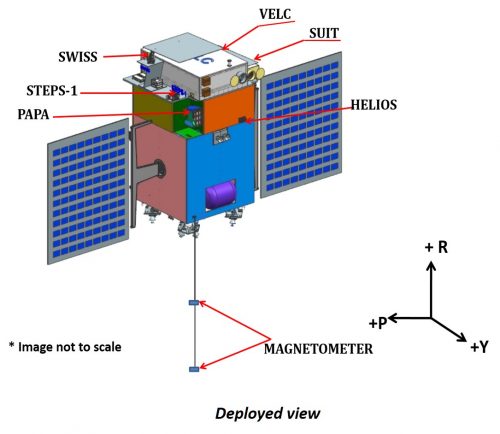Aditya – L1 First Indian mission to study the Sun 07/05/2019 – Posted in: Daily News
ADITYA-L1 FIRST INDIAN MISSION TO STUDY THE SUN
For: Preliminary & Mains
Topics covered: Mission, Objectives, Lagrange point, Halo orbit, L1 Point, Aditya-1 Vs. Aditya L1
News Flash
Chairman of Indian Space Research Organisation (ISRO) said that the India’s first mission to study the sun, Aditya-L1, will be launched in the first half of next year.
According to ISRO, Aditya-L1 mission is expected to be inserted in a halo orbit around the Lagrangian point 1 (L1) – which is 1.5 million km from the earth – so that there is a major advantage of continuously viewing the sun without any occulation eclipses.
Aditya-L1 was meant to observe only the solar corona.
Lagrangian point
A Lagrange point is a location in space where the combined gravitational forces of two large bodies, such as Earth and the sun or Earth and the moon, equal the centrifugal force felt by a much smaller third body. The interaction of the forces creates a point of equilibrium where a spacecraft may be “parked” to make observations.
These points are named after Joseph-Louis Lagrange, an 18th-century mathematician who wrote about them in a 1772 paper concerning what he called the “three-body problem.” They are also called Lagrangian points and libration points.
There are five Lagrange points around major bodies such as a planet or a star.
L1 Point
The first point, L1, lies between Earth and the sun at about 1 million miles from Earth. L1 gets an uninterrupted view of the sun, and is currently occupied by the Solar and Heliospheric Observatory (SOHO) and the Deep Space Climate Observatory.
Halo orbit
A halo orbit is a periodic, three-dimensional orbit near the L1, L2 or L3 Lagrange point in the three-body problem of orbital mechanics. Although the Lagrange point is just a point in empty space, its peculiar characteristic is that it can be orbited.
Aditya-1 Mission
The Aditya-1 mission was conceived as a 400kg class satellite carrying one payload, the Visible Emission Line Coronagraph (VELC) and was planned to launch in a 800 km low earth orbit.
The Aditya-1 mission has now been revised to “Aditya-L1 mission” and will be inserted in a halo orbit around the L1, which is 1.5 million km from the Earth. The satellite carries additional six payloads with enhanced science scope and objectives.
Aditya-1 Vs. Aditya L1
Aditya-1 was meant to observe only the solar corona. The outer layers of the Sun, extending to thousands of km above the disc (photosphere) is termed as the corona. It has a temperature of more than a million degree Kelvin which is much higher than the solar disc temperature of around 6000K. How the corona gets heated to such high temperatures is still an unanswered question in solar physics.
Aditya-L1 with additional experiments can now provide observations of Sun’s Photosphere (soft and hard X-ray), Chromosphere (UV) and corona (Visible and NIR). In addition, particle payloads will study the particle flux emanating from the Sun and reaching the L1 orbit, and the magnetometer payload will measure the variation in magnetic field strength at the halo orbit around L1. These payloads have to be placed outside the interference from the Earth’s magnetic field and could not have been useful in the low earth orbit.
Source: The Hindu
You can follow us on LinkedIn and for more updates related to UPSC IAS Preparation, Like our Facebook Page and subscribe our Diligent IAS Youtube Channel




